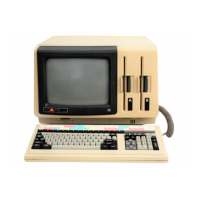Chapter 9
GSX-86: Graphics For
The
APe
This
chapter
describes the features
and
operating
procedures
of
GSX-86, the
Graphics System Extension
of
the CPM-86 Operating System.
It
explains what
GSX-86 does
and
how
you
can use its graphics functions. Later sections
of
the
chapter
describe the GSX-86 system's architecture.
WHAT IS GSX-86
GSX-86 incorporates graphics capability into the
CP/M-86
operating system
and
provides a host-independent
and
device-independent interface for application
pro-
grams. Graphics primitives are provided for implementing graphics applications
with reduced
programming
effort. OSX-86 enhances
program
portability by allow-
ing
an
application
to
run
on
any
CP/M-86
system with the GSX-86 option.
GSX-86
And
Application Programs
GSX-86 defines a
standard
interface to graphics peripherals from
an
application
program.
Application
programs
written in assembly language (or a high-level
language
that
supports
the GSX-86 calling conventions) can call GSX-86 with
appropriate
calls to the Graphics Devices Operating System (ODOS). You can
compile/assemble
and
link
programs
containing GSX-86 calls in the
normal
manner.
GSX-86 translates
GDOS
calls to fit the peculiarities
of
each graphics device
(printer,
plotter,
CRT,
and
so on). Since graphics devices are mechanically
and
electronically different, GSX-86 requires a special
program
(called a device driver)
to
run
each device. Application
programs
can use the device drivers
that
are
included as
part
of
GSX-86
on
the
CP/M-86
system distribution diskette (see Table
9-1). Alternatively,
you
can
create customized device drivers using the procedures
described later in this chapter.
9-1

